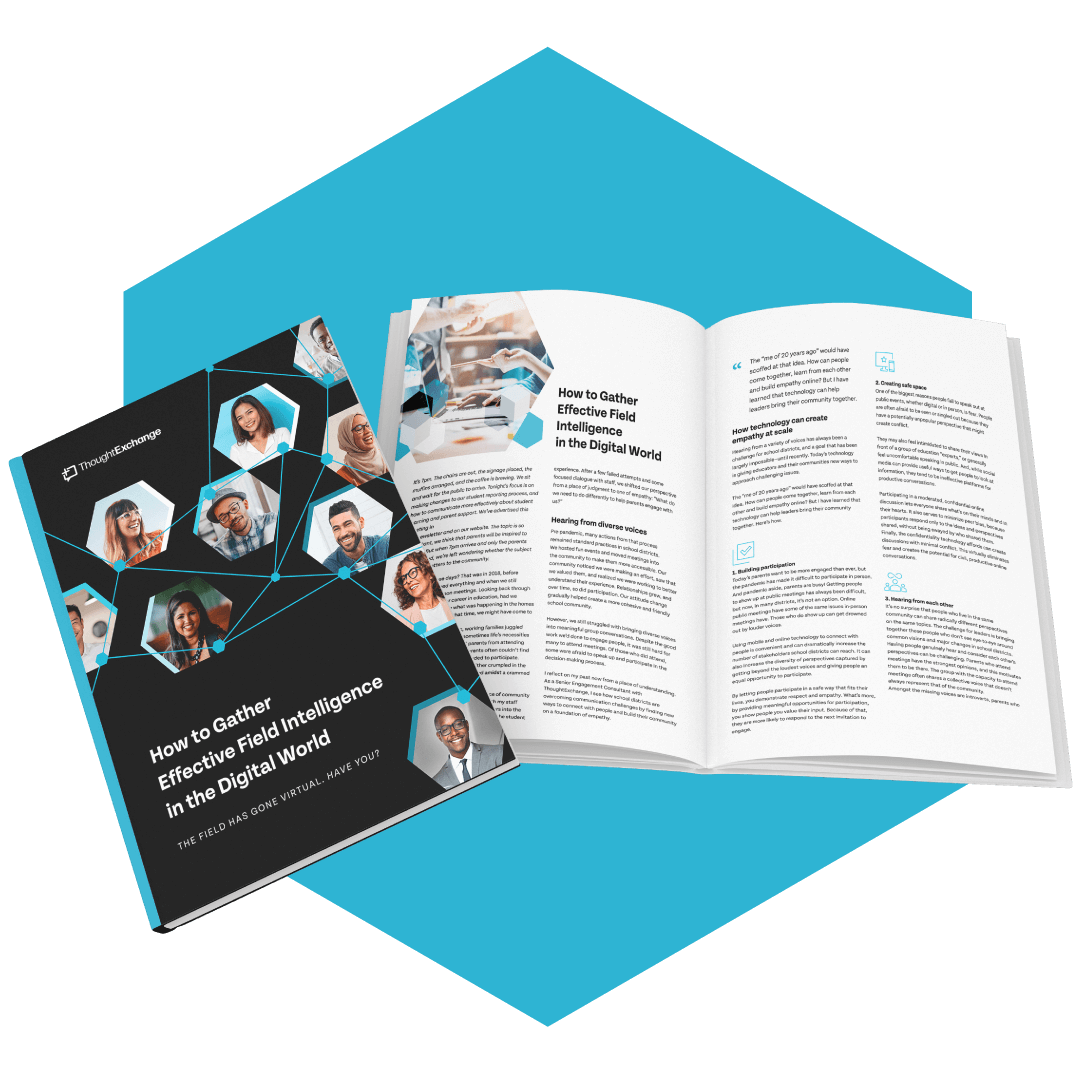September 21, 2021
Catherine Daly
Collective Decision-Making: Give your Teams a Voice
Workers are leaving their jobs at an unprecedented rate. McKinsey & Co.’s recent research into the “Great Attrition”—the fact that more than 15 million U.S. workers have quit their jobs so far in 2021—identified that employees want to feel valued and heard by their managers and organizations.
As leaders scramble to find new ways to connect with their people and stem the flow of talent from their teams, collective decision-making is arising as a popular way to facilitate meaningful engagement with employees on important issues.
→ Download Now: How to Gather Effective Field Intelligence in the Digital World
What is Collective Decision-Making?
Collective decision-making—also known as group decision-making or collaborative decision-making—occurs when a group makes a decision, and it’s no longer attributable to any single individual.
There is much to be gained from a collective approach to decision-making. After all, you’ve hired talented individuals on your team—why not tap into their talents to inform important decisions across the organizations.
An inherently inclusive process, collective decision-making is also one of the most successful ways to generate buy-in from stakeholders, build consensus, and encourage creativity in the workplace. According to the Project Management Institute, collective decision-making is most successful when a three-step decision-engineering process is adopted:
- Framing the decision
- Generating alternatives
- Deciding the course of action
1. Framing the decision
Framing a decision sets the overall context. To do this effectively, leaders should set out to critically examine the overall issue they face and seek to answer questions like:
- What is the ultimate objective of the decision?
- What is the root cause of the issue/problem?
- What are the outcomes/consequences of various decisions?
Another simple problem-framing technique—The Five Whys—recommends leaders keep asking the question “why?” until they get to the root cause of the problem or issue.
2. Generating alternatives
Once the problem is framed, and the context is understood, leaders should determine alternative solutions.

The more options generated, the greater the likelihood the team will uncover an innovative solution. In addition, involving everyone in the generation of these alternatives is a great way to gain fresh perspectives on your problem.
Idea creation can be conducted collaboratively and quickly using an enterprise discussion management tool that can source and rank ideas from across the organization in a fair and unbiased way to reduce the number of decisions and keep the group focused.
3. Deciding the course of action
When enough alternatives are created, the process of collective decision-making can begin. Again discussion management and decision analysis tools are useful for rooting bias and evaluating the alternatives and responses fairly.
This collaborative three-step process has proven to be effective across a range of organizations on issues ranging from deciding multi-million dollar investments to allocating resources. Once leaders deploy the decision, buy-in from stakeholders is almost guaranteed since everyone feels involved and responsible for the final decision and its eventual outcomes.
Collective Decision-Making in Large Organizations
Leaders who figure out an effective collective decision-making process can tap into collective intelligence and engage employees, making them feel valued and less likely to check out or leave the company.
The risks of making decisions in a group—especially in large organizations—include falling into groupthink or other biases that affect the process and the outcome. These risks are detrimental to critical reasoning and evaluation and can carry bad decisions forward to avoid upsetting the balance of a particular group.
According to this HBR article, there are several strategies to help ensure better collective decision-making. The most important of which are:
- Providing a safe space for people to share ideas
- Avoiding over-reliance on experts
- Sharing collective responsibility for the outcome
Providing a safe space for people to share ideas
To encourage employees to share opinions and engage in constructive discussions, leaders should ensure employees can speak up without fear of reprisal. Pixar offers some great ideas on how to do this. The company has baked these ideas into the company culture:
- Everyone must have the freedom to communicate with anyone
- It must be safe for everyone to offer ideas
- We must stay close to innovations happening in the academic community

However, organizations that are still working to build more collaborative cultures may need some quick ways to make a difference. In a scenario where group members feel uneasy presenting ideas in a brainstorming session, leaders can suggest taking the brainstorm online using an engagement tool like ThoughtExchange, for example, to give teams a voice on important issues efficiently and effectively.
With a well-formulated open-ended question, leaders can use ThoughtExchange to solicit feedback from their teams—whether employees are office-based or at home—on issues that benefit from collective decision-making. In doing so, leaders convey respect and interest in their employees’ thoughts and creative solutions.
Avoiding over-reliance on experts
Providing anonymous, safe spaces for employees to share ideas and preferences reduces the risk of groupthink and biased decision-making that can arise in other settings such as round table discussions.
In more public settings, the influence of perceived experts or senior leaders can overshadow those who are afraid to voice dissenting opinions. ThoughtExchange enables everyone in the group to share their views and suggestions and to vote on the contributions of others in a completely anonymous process.
Sharing collective responsibility for the outcome
All members should feel accountable for the collective decision-making process and its outcome. One way to ensure this is to ask the team to sign a responsibility statement at the outset, agreeing to accept the collective decision. This can balance the power in the group and create a more open exchange of ideas.
Hybrid and Remote Leaders’ Challenges in Decision-Making
Leaders of hybrid and remote teams often fall into the trap of basing their decisions on the opinions and feedback of those in their immediate vicinity, known as proximity bias. Proximity bias can adversely affect remote employees and employees who work remote part of the time. These employees already struggle with the feeling that they are missing out on important information, opportunities, and exposure to their supervisors. Leaving them out of important decisions only serves to exacerbate the problem.

Suffice to say, managing a hybrid team requires a new skill set—and a little help from technology—to ensure all team members have a voice in decision-making processes.
Leaders can design a more inclusive process for hybrid and remote teams by canvassing individuals on their views using employee engagement software. Platforms like ThoughtExchange facilitate collective decision-making and bridge the gap between co-located teams and their remote colleagues.
“Most executives aren’t listening to their people nearly enough. Don’t be one of those executives.”
McKinsey & Co. 2021
Collective Decision-Making in Practice
Some methods of conducting collective decision-making can create barriers to effective, efficient, and objective decisions. For example, survey tools with predetermined responses limit the scope of options to consider and select; in-person roundtables are prone to bias and groupthink, and email chains or shared documents create messy data that is difficult to analyze.
In addition, some employee engagement or survey tools promote the confidentiality of their data and results. However, this should not be confused with an anonymous process, where data can’t be diluted down to department or team level or include identifiers such as length of service or gender. If employees feel that their responses can personally identify them, there is an increased likelihood of withholding their true opinions due to fear of retribution for voicing concerns.
Similarly, many employees may choose not to respond. Low participation rates to surveys, coupled with censored responses, renders data invalid and may result in inaccurate assumptions and actions based on the feedback. ThoughtExchange eliminates this risk and enables leaders and organizations to gain a true reflection of the health of their organization. Armed with accurate and insightful data, organizations can quickly move to action with the added advantage of early buy-in from their teams.
ThoughtExchange’s platform also ensures the anonymity of responses and enables each participant to vote objectively on suggestions submitted by others. While the leader retains the capacity to veto any decision as deemed appropriate, they open up the flow of creative ideas across their team and create a positive culture where employees feel valued, heard, and respected.
As we turn a corner on the pandemic and return to a new normal, a significant portion of the workforce is weighing up their options to create a healthier and more meaningful working arrangement. McKinsey and Co.’s research warns that “most executives aren’t listening to their people nearly enough. Don’t be one of those executives.”
See how ThoughtExchange can help your business to connect with your most important assets—your people.




